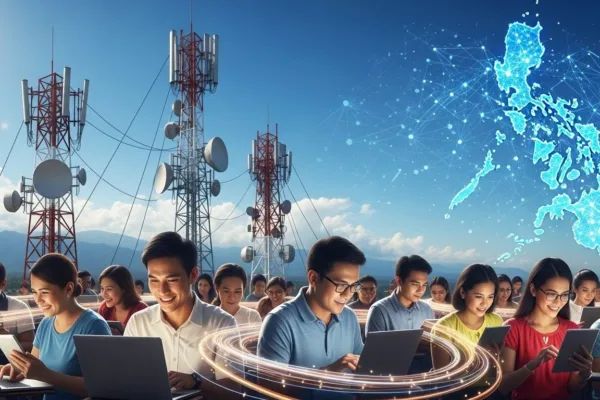by Bheaa Baarde, Correspondent
Cashless transactions, as well as buying products or services online, are getting more common nowadays.
I was one of those hesitant at first to engage in such transactions because of the fear of possible scams and other cybersecurity threats. Fast forward to today, or two years later, and who would have thought that I would join millions of Filipinos who now enjoy shopping online using mobile e-wallets?

The COVID-19 pandemic has certainly played a key role in transforming the Filipino consumers’ behaviors, which in turn enabled the Philippine fintech industry to flourish in spite of the economic setbacks brought about by the health crisis.
With the imminent digitalization of various industries and a growing number of digital-savvy consumers, what would be the future of the micro, small, and medium-sized enterprises (MSMEs) in the Philippines? And how does the growing fintech industry impact MSMEs?
The current state of the Philippine fintech industry
Fintech is already present in the Philippines even before the pandemic. But as I’ve mentioned earlier, the COVID-19 crisis has accelerated its growth with mobile wallets and online payment leading the way.
GCash, the Philippines’ leading mobile e-wallet, reported that they have already surpassed P500 billion mark in Gross Transaction Value (GTV) in March this year. In addition, 60 million Filipinos already have a GCash account, which accounts for 83 % of the adult population.
According to Robocash, a financial holding group, the number of fintech companies in the Philippines has grown from 126 in 2016 to 222 this year.
The number of active Fintech clients also registered significant growth, from 1.7-million in 2016 to about 54.1-million people in 2021. There was also an increase in transaction volume of $2 trillion (P996 billion). The Philippine fintech industry also reached a market value of $11 billion in 2021 and is expected to reach $44 billion by 2024.
With the impending success of the country’s payment digitalization program, the Bangko Sentral ng Pilipinas (BSP) is also tapping the fintech industry to also target MSMEs. This is expected to play a key role in the country’s economic recovery post-pandemic as MSMEs now comprise 99.6% of all businesses in the Philippines.
So, what are the Philippine government’s current fintech initiatives that can help boost MSME growth?
Simpler and more affordable payment facility
Mobile e-wallets have a QR code feature that allows users to make a purchase or transfer funds just by simply scanning a code instead of manually providing the account details. Convenient, right? But the downside to this is that it is only exclusive to your specific bank or e-wallet provider. So, if you are using GCash, you can only use the QR code to transact with other GCash users.
But this is not a problem anymore with the BSP’s QR Ph, which would now allow QR code payment and money transfers regardless of the bank provider.
In April 2021, the BSP extended payment use of QR Ph to include person-to-merchant (P2M) transactions. This is a big help for MSMEs as it will help make payment systems easier for them and their customers. At the same time, it would also be more cost-effective as the service is free.
“With the use of QR technology, small merchants are presented with a simpler and more affordable payment facility as compared to costly, point-of-sale terminals,” said Benjamin Diokno, BSP Governor.
Easier access to loans and lending firms
If you ever want to get a loan from a bank or similar other financial services providers, you will need to undergo a credit risk analysis. It is a process to assess a debtor’s payment capacity to know if they are qualified for a loan. Usually, banks rely on traditional data such as a creditor’s credit history and on-time payments. This gives unbanked individuals a smaller chance of getting a loan.
To address this issue, the BSP and a group of fintech industry leaders led by the FinTech Alliance.PH is now working on a system that utilizes data innovations to improve credit risk analysis. Aside from the traditional data, financial institutions can now use alternative data and big data as other sources for credit risk analysis. This way, the underserved Filipinos, which includes MSMEs, can have an easier time getting a loan even if they don’t have a bank account.
“With support from the various banking industry associations and the Department of Trade and Industry, the BSP will introduce the adoption of a standard business loan application form which will make the loan application documents of banks simpler and borrower-friendly,” Diokno added.
The BSP has also partnered with the Japan International Cooperation Agency (JICA) for their Credit Risk Database project, which aims to improve access to finance for SMEs by lessening a bank’s dependence on collateral during credit evaluation.
Digital banks empowering MSMEs
Another opportunity for MSMEs is the establishment of digital banks in the Philippines. The BSP has just granted licenses to six digital banks, namely, the Overseas Filipino Bank (OFB), Tonik Bank, UNO Digital Bank, GoTyme, UnionDigital Bank, and Maya Bank. All of them are expected to become fully operational by the end of this year.
According to Diokno, the framework of these digital banks is aligned with BSP’s financial inclusion goals wherein these banks can even serve MSMEs, which have little to no digital footprints in terms of historical electronic financial data.
“A common strategy for these digital banks is to engage MSMEs through simple and quick deposit onboarding, then empower them with a business solution platform that facilitates the digitalization of MSME operations. All these facilities may be accessed through a user-friendly mobile and web-based application system,” said the BSP governor.
Collaborative efforts needed
It is good to see that we are taking steps in advancing our MSMEs to financial inclusion and digitalization with a little help from the BSP. Despite positive prospects, the Philippine fintech industry is still unstable since the industry is still young. Support from the government, as well as a collaborative effort from the private sector, are important to ensure its future as well as the future of other sectors — like our MSMEs, that will rely heavily on its success.








